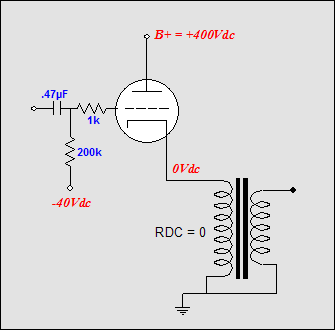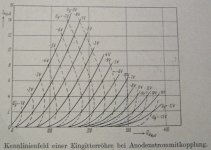Right.Wavebourn, is the current feedback from the 200R pot at the right/bottom pot (Rk2 perhaps but it's a bit fuzzy)?
I'm guessing the voltage nfb is from Rf1 (60k)..
Zobel in parallel with primary is very essential also.
I.e. as the 6V6 conducts it pulls the centre of the 200R pot upward (current sense) and the anode pulls downward (voltage of anode vs centre point of 200R pot).
Right.
It's interesting because at no time does the voltage feedback actually reference the voltage of the primary, just of (B+ - primary voltage - a bit of Rk2) which means PSU ripples etc will not get corrected?
No, ripples on speaker can't be corrected by such feedback, since it decreases effective Rp of the tube.
I wonder if there would be a benefit to drive the OPT with a cathode follower and ground the centre tap so the cathode feeds back the actual primary voltage? What do you think - has anyone done this?
Do you mean split-load transformer, or negative feedback by voltage from transformer to cathode?
Yes, it had been done many times.
with a cathode follower output stage you simply shift your problems to the driver stage. Furthermore it's kinda waste of tubes. Simply use a Source follower and you don't need a tube, OPT and huge amount of signal voltage from the driver.
I don't exactly get what you mean. Can make a drawing or explain more ?
BTW, Wavebourn posted a very nice EL84 amplifier circuit some time ago which uses neg. voltage- and pos. current feedback:
BTW-2, I attached a copy of a triode (contin. line) and with pos current feedback (dashed). It is quite interesting what the feedback does here. It's from the book 'Rothe, Kleen - Elektronenröhren als Anfangsstufen-Verstärker'
I wonder if there would be a benefit to drive the OPT with a cathode follower and ground the centre tap so the cathode feeds back the actual primary voltage? What do you think - has anyone done this?
I don't exactly get what you mean. Can make a drawing or explain more ?
BTW, Wavebourn posted a very nice EL84 amplifier circuit some time ago which uses neg. voltage- and pos. current feedback:
An externally hosted image should be here but it was not working when we last tested it.
BTW-2, I attached a copy of a triode (contin. line) and with pos current feedback (dashed). It is quite interesting what the feedback does here. It's from the book 'Rothe, Kleen - Elektronenröhren als Anfangsstufen-Verstärker'
Attachments
Thanks for the info guys, yes my cathode follower musing was this:

http://www.tubecad.com/2005/June/blog0048.htm
Which gives the low impedance drive and proper feedback path (the primary is grounded), but the demands on the driver and heater supplies rules it out.
The positive current feedback is an excellent idea though - because at least that is pure - do I need a zobel with that too?
Would a zobel improve 'normal' amps too?
Then I'll want some kind of aikido feedback of the PSU, I know push-pull helps that but I can't help thinking that some of the time one tube may not be conducting - at which point the PSU noise is again in the frame.
So I guess I'm now looking at 1) positive current feedback (easy to do via cathode resistors), 2) negative voltage feedback via the anode + cap (feeds back a version the PSU B+ minus the primary voltage), and then a term of the PSU voltage (a la aikido) that will add in and make sure the actual feedback is equal to the primary voltage, and cancel the hum and audio variations.
The aim is to create a push-pull amp (with GU50 pentode mode with 500V plate) that presents a very low impedance to the primary, and to leave the secondary alone to do its own thing with the speaker (no GNFB).
Maybe Schade feedback combined with positive current feedback and PSU noise cancellation injection is the way forward here.

http://www.tubecad.com/2005/June/blog0048.htm
Which gives the low impedance drive and proper feedback path (the primary is grounded), but the demands on the driver and heater supplies rules it out.
The positive current feedback is an excellent idea though - because at least that is pure - do I need a zobel with that too?
Would a zobel improve 'normal' amps too?
Then I'll want some kind of aikido feedback of the PSU, I know push-pull helps that but I can't help thinking that some of the time one tube may not be conducting - at which point the PSU noise is again in the frame.
So I guess I'm now looking at 1) positive current feedback (easy to do via cathode resistors), 2) negative voltage feedback via the anode + cap (feeds back a version the PSU B+ minus the primary voltage), and then a term of the PSU voltage (a la aikido) that will add in and make sure the actual feedback is equal to the primary voltage, and cancel the hum and audio variations.
The aim is to create a push-pull amp (with GU50 pentode mode with 500V plate) that presents a very low impedance to the primary, and to leave the secondary alone to do its own thing with the speaker (no GNFB).
Maybe Schade feedback combined with positive current feedback and PSU noise cancellation injection is the way forward here.
Last edited:
I would suggest to deal with ripples at their lair; in PS. I prefer sand assisted tube amps, it is the way to go when nice sand is available, as opposed to 50 years ago when it was only in dreams of home audio designers. One MOSFET and string of Zeners, and it is hollow like in the tank.
I would suggest to deal with ripples at their lair; in PS. I prefer sand assisted tube amps, it is the way to go when nice sand is available, as opposed to 50 years ago when it was only in dreams of home audio designers. One MOSFET and string of Zeners, and it is hollow like in the tank.
It's a good idea, especially for stability. Sometimes I like to think of an amplifier as a voltage controlled power supply, as we have the power source, the output tube and the means to modulate it. I.e. to move some of the regulation function of the PSU into the amp itself.
One day I'll get enough 6s (24V) Lipo batteries (and an easy way to charge them without burning my house down) to make a battery powered set - that would be an interesting listen
- Status
- This old topic is closed. If you want to reopen this topic, contact a moderator using the "Report Post" button.
